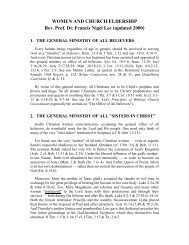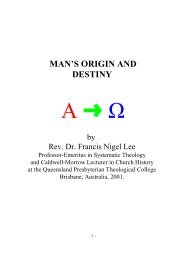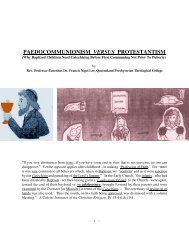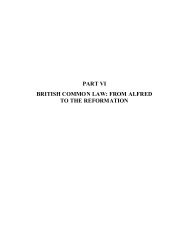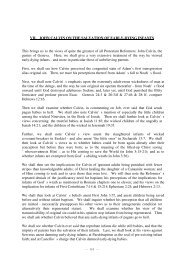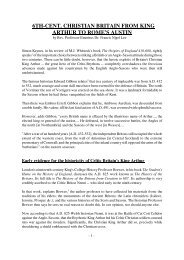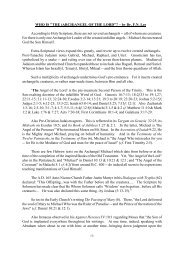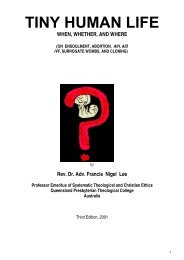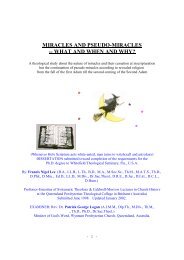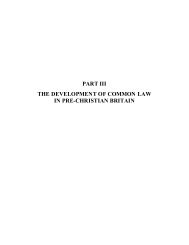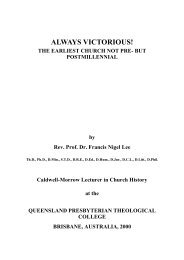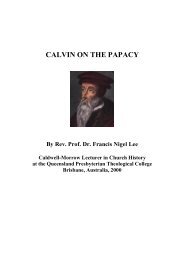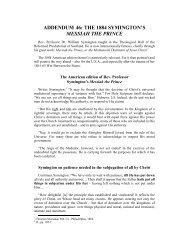THE CHRISTIAN AFRIKANERS - The Works of F. N. Lee
THE CHRISTIAN AFRIKANERS - The Works of F. N. Lee
THE CHRISTIAN AFRIKANERS - The Works of F. N. Lee
You also want an ePaper? Increase the reach of your titles
YUMPU automatically turns print PDFs into web optimized ePapers that Google loves.
Victoria West. It is very interesting to see the way the General Assembly <strong>of</strong> the Reformed Churchhandled these maverick congregations. <strong>The</strong>y urged the seceding congregations to come back totheir Church, and to participate in the processes <strong>of</strong> Presbytery and General Assembly. But they usedno force against the seceding congregations to try and attach their property, nor to prevent themfrom seceding.<strong>The</strong> General Assembly finally got around to disciplining the five liberal Preachers to whom Ireferred. <strong>The</strong>y were men who felt it nonsensical to pray that God would send rain (because they feltGod has predestinated before the foundation <strong>of</strong> the world whether it will rain or not). That was theessence <strong>of</strong> the liberalism <strong>of</strong> these men. When these Ministers had finally been disciplined, all <strong>of</strong>these secessionist congregations returned to the General Assembly. But those who had establishedthe tiny new denomination in 1857, did not.<strong>The</strong> only other movement into liberalism I am aware <strong>of</strong> in the Reformed Church, took place in the1930's. <strong>The</strong> world famous Missiologist and great New Testamentician Pr<strong>of</strong>essor J.J. du Plessis wasthen quite the most "evangelical" man in the Reformed Church <strong>of</strong> South Africa -- a real soulwinnerand missionary-minded individual. He wrote the standard work at that time on theevangelisation <strong>of</strong> Africa in the English language. He also started his own newspaper called "<strong>The</strong>Searchlight" -- in which he drew attention to the fact that not so much the written word in theBible, but rather the living Christ was where the emphasis should rest. Indeed, he correctlyprotested against a certain amount <strong>of</strong> dead orthodoxism in the Church.But unfortunately, he also drew attention -- as a Pr<strong>of</strong>essor at the Stellenbosch <strong>The</strong>ologicalSeminary! -- to four or five Bible texts which he felt were not fully infallible. A couple <strong>of</strong> themwere in the books <strong>of</strong> Samuel and Chronicles, involving dates.More seriously, however, he also took the position that Christ had become so much bone <strong>of</strong> ourbone and flesh <strong>of</strong> our flesh at His incarnation, that -- though God before His incarnation and thoughagain God after His ascension into heaven -- our Saviour had not only decided not to exercise Hisdivine attributes during His earthly incarnation, but had in fact then laid aside His divine nature.Christ did, however -- asserted Du Plessis -- assume it again, after the completion <strong>of</strong> His fullyhuman work in keeping the covenant <strong>of</strong> works as the second Adam to the end <strong>of</strong> His earthly life.Well, this marks a very interesting chapter in the history <strong>of</strong> the Reformed Church. <strong>The</strong> brother <strong>of</strong>the previous Prime Minister <strong>of</strong> South Africa whom I knew very well, Rev. Dr. Koot Vorster -- apersonal friend <strong>of</strong> mine -- himself told me <strong>of</strong> the amazing things that happened in the StellenboschSeminary and at the University while this particular furore was taking place in the l930's.Dr. Vorster said a group <strong>of</strong> very conservative students were very grieved about this heresy in theirSeminary. So they went out one night, and put their hands round an enormous oak growing in theseminary garden. It was a massive tree that looked like it could live for another couple <strong>of</strong> hundredyears. <strong>The</strong>y linked hands around this oak tree, touched it, and prayed an imprecatory prayer. <strong>The</strong>yprayed that if heresy, in the eyes <strong>of</strong> Jehovah, was indeed ever being taught in the <strong>The</strong>ologicalSeminary -- that Almighty God would shrivel up that oak tree till nothing was left <strong>of</strong> it! From thenext day or so onward, that sturdy oak tree began to shrivel up from the root!Yet the wrangling continued. I think you would agree with me that although heresy was indeedinvolved, it was not the worst kind <strong>of</strong> heresy in which one could possibly have been embroiled.Indeed, it was evangelically motivated by a man whose dedication to the Kingdom <strong>of</strong> Christ wasbeyond reproach. Nevertheless the matter went up for adjudication by the highest court <strong>of</strong> theChurch. Du Plessis was found guilty on five points <strong>of</strong> heresy by the General Assembly.Consequently, he was removed from his teaching <strong>of</strong>fice at the Seminary.



